How to Fix ESRV_SVC_WILLAMETTE Event Viewer Errors
Several Windows users have been reaching us with questions after opening Event Viewer and discovering that it’s full of critical errors that can be traced back to the ESRV_SVC_WILLAMETTE component. In most cases, the error explanation says that the ESRV_SVC_WILLAMETTE component cannot be found or is not correctly installed on the local computer. The issue is reported to occur on Windows 7, Windows 8.1 and Windows 10.

What is ESRV_SVC_WILLAMETTE?
ESRV_SVC_WILLAMETTE originating from the esrv_svc.exe filename is a file used by several Intel genuine components including Intel Energy Checker and Intel Driver Update. The default location for it is inside %Program Files%\Intel\SUR\WILLAMETTE\ESRV\.
If the error you’re encountering is pointed towards a different location and you didn’t install the Intel suite in a custom location, you might also want to consider the possibility of malware in disguise. In this case, we encourage you to follow this guide (here) on performing a deep scan with Malwarebytes.
What is causing ESRV_SVC_WILLAMETTE Event Viewer Errors?
We investigated this particular issue by looking at various user reports and trying out different repair strategies that most affected users have successfully deployed in order to fix this particular problem. As it turns out, the error can be caused by any of the following culprits:
- Malfunctioning Intel application – In the vast majority of reported cases that we analyzed, the issue ended up being caused by a malfunctioning Intel application. Intel Driver Update and Intel Energy Checker are top of this list. If you have one of these applications installed, uninstalling them or at least reinstalling them should allow you to resolve the issue.
- Different Conflicting application – It’s also possible that a different 3rd party service or process that can’t be identified so easily is actually causing the constant Event Viewer errors. In this case, starting your computer in a Clean Boot State should allow you to identify the culprit and resolve the issue for good.
- Underlying system file corruption – System file corruption is another problem causer in this case. If this scenario is applicable to your current situation and you suspect that the issue might be caused by an underlying corruption problem, running DISM or SFC scans should resolve the problem.
Method 1: Uninstalling malfunctioning Intel application
As it turns out, this Event Viewer Error is often associated with a malfunctioning Intel application. In the vast majority of cases, affected users are pointing towards Intel Driver Update and Intel Energy Checker. If you’re using one of these two utilities or a similar one published by Intel, then following the steps below to uninstall the application should end up resolving for good.
Here’s a quick guide on uninstalling the malfunctioning Intel application using the Program and Features utility:
- Press Windows key + R to open up a Run dialog box. Then, type “appwiz.cpl” and press Enter to open up the Programs and Features window.

Type appwiz.cpl and Press Enter to Open Installed Programs List - Once you’re inside the Programs and Features windows, scroll down through the list of available applications and locate the utility published by Intel that you suspect might be causing the issue (Intel Driver Update, Intel Energy Checker, or something else)
- When you manage to identify the application that is known to cause the issue, right-click on it and choose Uninstall. Then, follow the on-screen prompts to complete the uninstallation, then restart your computer.
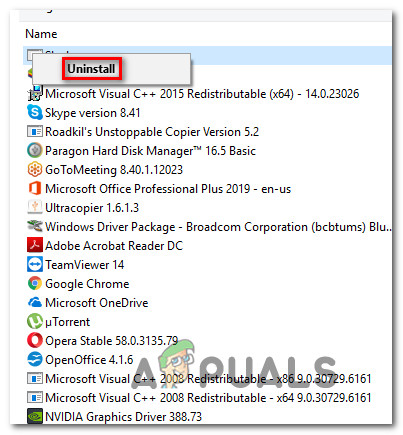
Uninstalling the conflict causing the application - Once the next startup sequence is complete, see if the same issue is still occurring by using your computer regularly and checking Event Viewer from time to time.
Note: If you rely on the Intel application that you just uninstalled, you can reinstall it again. Most affected users have reported that the issue was no longer occurring once the application was reinstalled.
If the same ESRV_SVC_WILLAMETTE errors are still popping up regularly, move down to the next method below.
Method 2: Clean Boot State
If the methods above didn’t allow you to discover the culprit that might be causing the Event Viewer errors, you should be able to discover the cause of the issue by starting your system up in Clean Boot mode to eliminate any 3rd party distractions.
If you noticed that no new Event Viewer errors pointing towards ESRV_SVC_WILLAMETTE appear while your system is running in clean boot mode, it’s clear that one 3rd party service or process is causing the issue. In this case, you can follow a series of instructions to identify the component responsible for the error and remove it from your system.
Several affected users have reported that they managed to resolve the issue by booting their computer without any 3rd party service or application. Here’s a quick guide on achieving a clean boot state to eliminate the possibility of a software conflict:
- First things first, start by ensuring that you’re using a Windows Account with admin privileges.
- Then, press Windows key + R to open up a Run dialog window. Next, type “msconfig” and press Enter to open up the System Configuration window. When you’re prompted by the User Account Control (UAC) window, click Yes to grant administrative privileges.
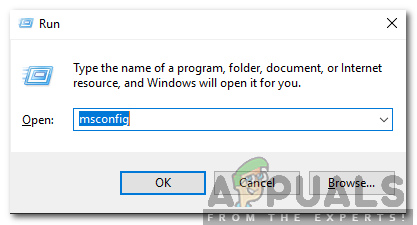
Typing in msconfig and pressing enter - Inside the System Configuration window, select the Services tab from the horizontal menu at the top. When you get to the correct location, start by checking the box associated with Hide all Microsoft Services.
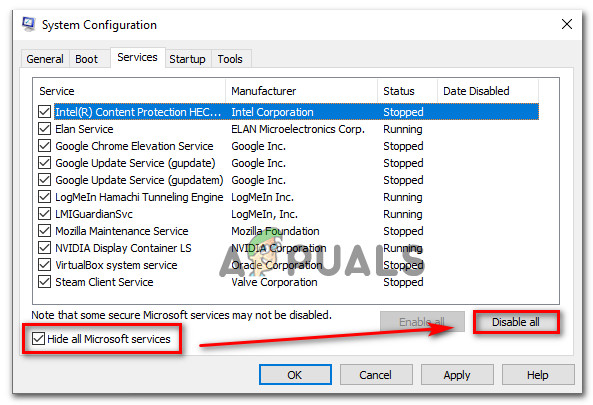
Disabling all non-Microsoft startup items Note: By taking this step, you’re effectively ensuring that you’re not disabling any critical services needed by your operating system.
- At this point, you should only see a list of 3rd party services. If the Microsoft services are hidden, click the Disable All button to prevent any 3rd party services from causing the Event Viewer error.
- Once services that aren’t essential to the well functioning of your OS have been hidden and the rest have been disabled, click Apply to save the configuration.
- When you get this far, move over to the Startup tab and click on Open Task Manager.
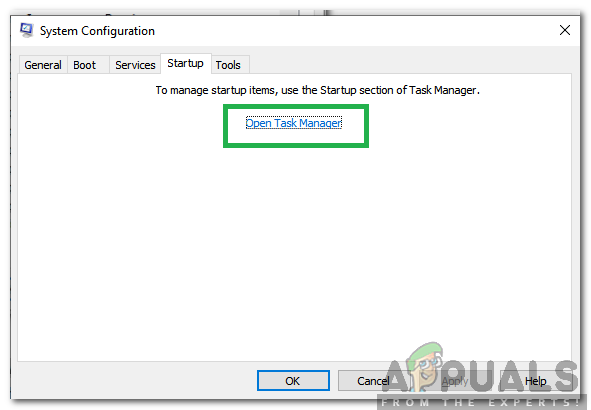
Clicking on “Startup” and selecting “Open Task Manager” - Once you’re inside the Startup tab of Task Manager, select teach startup service individually and click the Disable button associated with each entry to prevent them from running at the next startup.
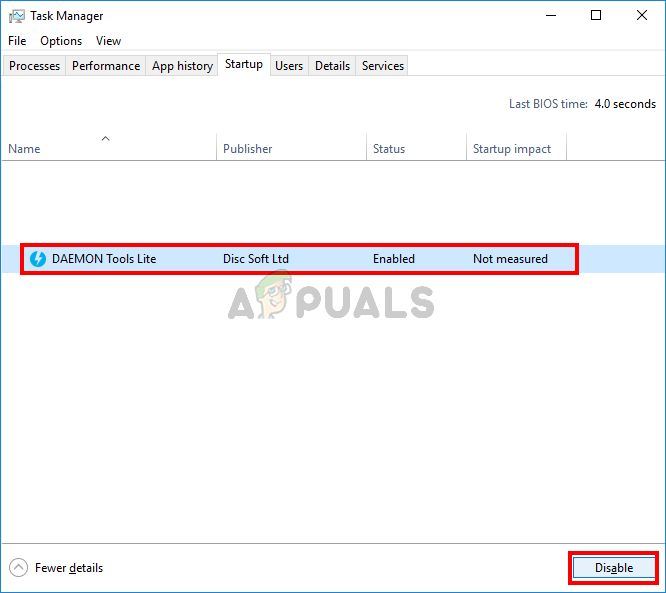
Disabling Apps from Startup - Once every startup item is disabled, you should have achieved a clean boot state. At this point, all you need to do is close Task Manager and restart your computer.
- When the next startup sequence is complete, start using your computer normally and see if you’re still seeing event viewer errors associated with ESRV_SVC_WILLAMETTE. If the issue is no longer occurring, you can conclude that one of the services/apps that you previously disabled is causing the issue.
- In this case, re-enable each item that you previously disabled systematically coupled with random restarts until you manage to identify the culprit. It will take you some time, but you’ll eventually discover the culprit that’s causing the issue.
If you’re still encountering the ESRV_SVC_WILLAMETTE even when in a clean boot state, move down to the next method below.
Method 3: Performing SFC and DISM scans
Based on various user reports, system file corruption can also be responsible for the ESRV_SVC_WILLAMETTE Event Viewer error. Even if the Intel Update Driver Software is not tainted by corruption, it’ possible that a dependency is, so the error will still be tied up to ESRV_SVC_WILLAMETTE.
If this scenario is applicable, the easiest and least intrusive way to fix this is to repair the corrupted files with utilities like Deployment Image Servicing and Management (DISM) and SFC (System File Checker).
Both of these utilities are perfectly capable of resolving the issue, but they do it in different ways, so running them both is recommended. SFC relies on a local cache archive to replace corrupted files with fresh copies while DISM used Windows Update to download fresh copies in order to replace corruption.
Here’s a quick guide on running an SFC and a DISM scans in order to fix corruption and resolve constant ESRV_SVC_WILLAMETTE Event Viewer errors:
- Press Windows key + R to open up a Run dialog box. Then, type “cmd” and press Ctrl + Shift + Enter to open up an elevated Command Prompt. When you’re prompted by the UAC (User Account Control), click Yes to grant admin access.

Running CMD as an administrator - Once you’re inside the elevated Command Prompt, type the following command and press Enter to initiate the SFC scan:
sfc /scannow
Note: Once you start this process, we strongly recommend against stopping the procedure by closing the CMD window manually or by restarting your computer, since you risk further corruption damage.
- When the process is complete, restart your computer and see if the issue is fixed at the next system startup.
- If you’re still noticing Event Viewer Errors pointing towards ESRV_SVC_WILLAMETTE, follow step 1 again to open up another elevated command prompt, then type the following command to initiate a DISM scan:
DISM /Online /Cleanup-Image /RestoreHealth
- Once the process is finished, restart your computer once again and see if the issue has been resolved at the next startup sequence.




